How to grow French beans: our complete growing guide
Add a little ‘ooh la la’ to your summer harvests as we show you how to grow French beans – and how to keep them coming!


Pencil thin or flat-podded, purple, green or yellow – once you know how to grow French beans, you’ll never look back.
This easy-to-grow bean comes in lots of shapes and colours. Some are happy clambering up rustic poles in a kitchen garden, while others thrive in patio pots. There are so many options with this cheeky cropper, you’re spoiled for choice.
Also known as the ‘common bean’ (Phasaolus vulgaris), there’s nothing average or humdrum about this abundant annual. With the right care, these beans will reward you with months of moreish harvests. They just need well-drained, crumbly soil or a large container, a frost-free space, and a little tender loving care.
Decide whether you want to devote space to climbing French bean varieties that can scale supporting poles – or whether you’d prefer to focus on bushy dwarf plants you can nurture in pots. Then follow our go-to guide, and you too can quickly cultivate a rainbow of tasty pods. Here’s to a productive summer of blissful bean delights!
Want to try growing other varieties of beans too? Don't miss our guide on how to grow runner beans too.
What are the different types of French beans?
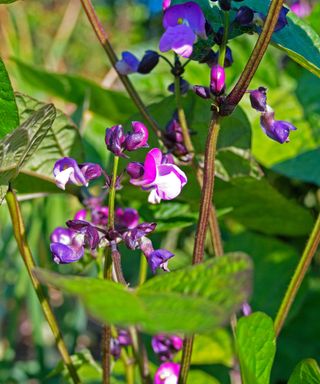
French bean flowers like those of this dwarf ‘Purple Queen’ are self-pollinating
We’re all familiar with the slender green beans available in supermarkets, but there’s a lot more out there for gardeners to try. Before you find out how to grow French beans, it’s important to get a feel for the characteristics and habits of the main types.
The bushy dwarf type is great for container gardening ideas and small spaces, and reaches 2ft (60cm) high. Dwarf beans start producing pods 10 weeks after direct-sowing in the ground, or less if started off inside. Bushy bean varieties include ‘Purple Teepee’, ‘Nomad’, ‘Golden Teepee’, ‘Amethyst’, ‘Tendergreen’ and ‘Sonesta’.
Then there’s the climbing French bean. Well suited to expansive plots with room to stretch, they can reach 6ft (1.8m) tall. Climbers produce a larger crop for a longer period, starting 12 weeks after direct-sowing. Try ‘Cobra’, ‘Blue Lake’, ‘Monte Gusto’, ‘Hunter’, ‘Pantheon’, ‘Golden Gate’ or crimson ‘Borlotto Lingua di Fuoco Nano’.
Climbers produce a steady supply of pods from one sowing. Dwarf varieties produce pods in flushes and benefit from early and late sowings (with the latest in July). The flowers of both types are self-pollinating, so undercover crops don’t need to be accessible to bees.
They are reliable, easy to grow and don’t have the pod setting issues that can sometimes happen with runner beans.
When to grow French beans
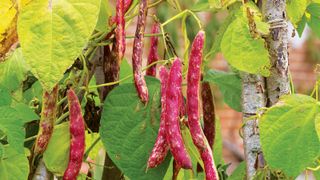
Sow climbing variety 'Borlotto Lingua Di Fuoco' between April and June for crops in high summer
You have a long window for growing these plants, but make sure conditions are plenty warm enough at each stage. Even a light cold snap can be deadly. Wait until all threat of a late frost has passed before planting or direct-sowing outside.
If you want to know how to grow French beans that go the distance, the sowing guideline is April-July. Early sowings can be made in pots undercover, planting out (or sliding seedlings out in growbags) when things warm up.
If you opt for direct-sowing outside, it’s wise to warm the soil first with a cloche. Compost and soil temperatures need to be at least 10°C (50°F).
Best results tend to come from sowing in May. If your soil is light and free-draining and you live in slightly warmer areas, such as the south of the UK, you can sow under rigid cloches a little sooner. Our guide on how to protect plants from frost can help with other tips for dealing with possible cold snaps.
How to grow French beans
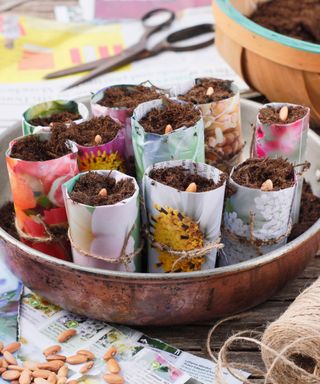
You can sow French bean seeds in homemade paper pots as long as the roots have adequate space to grow
French beans have a reputation for being quick on their feet. Because they grow fast, it’s important there are no sudden checks (or shocks) to their growth. Give some thought to soil conditions - this means warmth, and also fertility.
Before sowing or planting your beans, dig the soil well and make sure it is crumbly. It’s good to do this a few weeks before sowing or planting. Add lots of bulky, well-rotted organic matter or garden compost - you can find out how to compost in our guide. Work in an organic fertilizer such as fish blood and bone if you can.
The beauty of learning how to grow French beans is the prolonged harvest period. You can enjoy a steady supply of pods through to October, depending on variety. Keep sowing every three weeks. Successional sowing (repeat sowings) until July will give you a very good chance of seeing crops until the first winter frosts.
1. Sow French bean seeds indoors
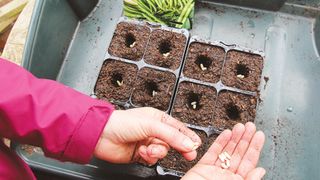
French bean seeds should be sown in deep cells, modules or pots indoors as the roots grow quickly
Sow in modules or 3.5in (9cm) pots undercover. This helps plants crop two or three weeks earlier than direct-sowing outside. Make sure the pots you use have drainage holes, and use potting compost. Water the compost well and leave to drain.
Place one or two seeds in each pot or cell. French beans can develop a big root system, so make sure the hole is 2in (5cm) deep. Cover with compost. Water lightly, and place in a propagator at 18-20˚C (64-68˚F) until germinated. Keep plants watered.
When you see seedlings appear (seven-10 days after sowing), move the pots to a light windowsill or a frost-free greenhouse. (For more tips on what to grow in a greenhouse each month, see our guide.)
If you have lots of seedlings, thin to the strongest one per pot. If you sow in May, your beans will be ready for planting out in June.
2. Harden off indoor French beans
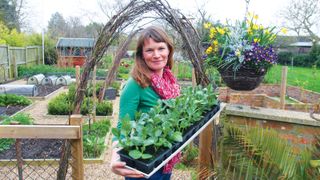
French beans need hardening off for around 10 days, with the exact number of days depending on weather and bean variety
As you learn how to grow French beans, you’ll find the young plants grow quickly. A couple of weeks after the seedlings appear, you can get them ready for life outside. This will take around a week to 10 days, depending on the weather and the variety.
If your plants have been on a windowsill, leave them in a cooler room for a couple of days. Then start moving them out to a sheltered part of the garden for longer every day, but bring them back in at night. This will help to toughen them up.
Then leave plants out permanently (in their pots) for a few days. Use a cloche or the best mini greenhouse if there is still the risk of colder nights. After this, they are ready for planting. You can find out more about how to transplant seedlings with our guide.
3. Sow French bean seeds outdoors
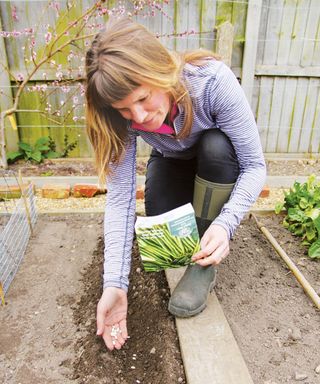
You can direct-sow French beans outside once the ground is warm and fertile enough
You can direct-sow French bean seeds outdoors in the ground or in pots once the weather (and ground) is warm enough. In most places, this is possible from the second or third week of May. Emerging seedlings need protection at night from a cloche or similar.
Mark holes 2in (5cm) deep with a dibber, and sow one bean seed every 4in (10cm). If you are sowing more than one row, make sure the rows are around 18-20in (45-50cm) apart. Cover with fine soil, then water in well.
Check your beans have labels. The seedlings should emerge in seven to 10 days. At this point, they can be thinned out. If you are growing a dwarf bean variety, direct-sow again through June and July for later harvests.
Want to try growing in raised beds? Read our raised garden bed ideas to find out more.
4. Planting out French beans
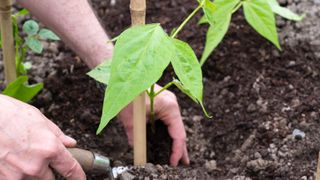
When planting, make sure that climbing bean varieties such as 'Cobra' are planted 8in (20cm) apart
After hardening off in late May, your French beans are ready to plant out in a sunny spot in June. If you are planting a climbing variety, make sure you have supports in place for the beans to clamber up as they grow.
Ideally, your bean plants need to be 3in (8cm) high or more. Make sure the planting hole is a bit larger than the pot. Remove each seedling, trying not to disturb the rootball. Place the plant in the hole and fill with compost or soil, then water in well.
Spacing is crucial for healthy root growth. With climbing varieties, check each French bean plant is 8in (20cm) apart. If you are planting in rows, make sure the rows are 18-20in (45-50cm) from each other. Dwarf bean varieties are best grown in small blocks so they can support each other, and these can be spaced 6in (15cm) apart.
5. Pick the right supports for French beans

As climbing French bean plants like 'Blue Lake' rise up the supports, fasten them in place at 8in (20cm) intervals
Part of figuring out how to grow French beans that will flourish is making sure they stay upright. If you are growing a climbing variety, it’s important to erect some support (unless they are growing up a trellis).
This can be a double row of bamboo canes, with rows 18-20in (45-50cm) apart to match the plants. The canes should be 6ft (2m) high, tied together at the top. Connect with wire netting.
Alternatively, opt for rustic twiggy wigwam-style supports (6-8ft high) that will suit the aesthetic of cottage garden ideas. To make a wigwam, use four or five canes, spaced 6in (15cm) apart at the base. To find out more about climbing plant support ideas, read our guide.
As the plants rise up the supports, fasten them to the canes every 8in (20cm). When the beans reach the tops of the supports, pinch out the tips to stop them getting taller. This also encourages bean production.
Dwarf French beans won’t need stakes if they are planted in blocks. But you can place some twiggy sticks or raspberry bush prunings around your beans to keep them in place.
Where to grow French beans
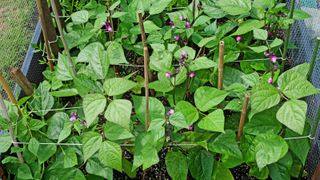
French Bean 'Purple Queen' will thrive in a warm, sheltered spot, and a raised bed can help moderate soil temperatures
Part of knowing how to grow French beans is picking the right spot. Yes, they are pretty low-maintenance once established, but the wrong soil or exposed site can stop them in their tracks. Make sure you pick a sheltered spot, preferably a south-facing wall of a garden. If you are worried, erect a windbreak.
The soil needs to be well-draining as well as fertile. French beans will struggle in heavy, water-logged soils. These plants will also struggle in clay soils. If you aren’t sure about the kind of soil you have, read our guide to soil types for help.
Your planting site also has to be sunny: French beans aren’t big fans of the cold or damp. These plants are native to Central and South America and crave sunshine. They can still manage in light or partial shade, but you’ll be thanking us later if you find the sunniest spot you can.
How to care for French beans
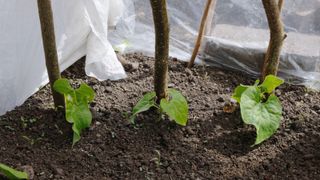
After planting, it’s a good idea to cover young French beans with mesh netting, horticultural fleece or plastic sheeting
As tender annuals, French beans are especially vulnerable to cold spells once planted outside – and late frosts are still possible as late as May. After planting, it’s a good idea to cover French beans with mesh netting, horticultural fleece or plastic sheeting. This also helps stop birds nibbling the leaves.
When learning how to grow French beans, remember: water thoroughly, and often. These plants will need lots of moisture, especially when the plants are flowering and podding. Don’t be afraid to give them a good soak, particularly in dry spells.
Also mist in the evenings to help pods set. Soak up some more tips on watering plants by following our guide.
The roots of these plants work hard to stretch low into the earth to extract all the nourishment they can. Still, you can give French beans a helping hand here, too. Maintain a steady level of moisture in the earth with a mulch of well-rotted manure or mushroom compost in July. Find out more about mulching in our guide.
You should also give these plants a high-potash feed such as liquid tomato feed every fortnight. This will help to boost your beans’ cropping potential.
How to deal with French bean problems

Growing French marigolds nearby can help to keep pests like whitefly and aphids off your French beans
When you learn how to grow French beans, you may soon find they are irresistible to all manner of pests, but worry not. Just follow these tips to stay one step ahead:
- It’s quite common to see silvery trails on the leaves of young plants that have been planted out: the evidence of slugs and snails. To combat this, cover plants with large plastic bottles that have been ‘topped and tailed’. Alternatively, try ‘slug pubs’ (cups or dishes of beer) placed nearby. For more on how to get rid of slugs, read our guide.
- Some French beans are susceptible to a disease called bean mosaic virus. Tell-tale signs are yellow patches on leaves and stunted growth. There’s not a lot you can do to save plants that have it – but you can choose French bean varieties with natural resistance (eg ‘Golden Gate’ and ‘Monte Gusto’).
- White spotting on leaves is a sign of fungal infection. This can happen if the weather is very damp for long periods. This isn’t curable, but you can salvage the plant, and the beans will still be edible. A good tip: prune any foliage that might be touching the ground to avoid rain splash.
- French bean plants can also fall victim to black bean aphid attacks. You will see dark clusters around leaves and tips if the plant is affected. Apply a strong jet of water, or control populations by squashing them (yes, we know this is icky). There's more tips on how to get rid of aphids in our guide.
- Growing French marigolds nearby can keep whitefly and aphids off your beans. Marigolds also attract beneficial insects like ladybirds, which love eating blackfly. Read our guide to companion planting to find out more about clever combinations of plants to combat pests and yield better crops.
When to harvest French beans

You can pick French beans such as 'Cosse Violette' continuously from July to first frost
Once you have mastered the art of how to grow French beans, you can get ready for harvests! Here’s how to ensure you are enjoying these beans at their best:
- It takes about eight-12 weeks from sowing for the beans to be ready to harvest. Pick these beans regularly from July to first frost (usually October). Keep picking, or the plant will stop cropping.
- For the sweetest flavours, select pods that are 4-6in (10-15m) long. You should hear a satisfying ‘snap’ when you pick the beans. Take care not to pull too hard. If you unsettle the plant, this may also halt production.
- Picking the pods while young and ‘beanless’ ensures massive yields. Do this twice a week at least, and daily in high summer. If you don’t, the beans will halt production, and the harvests will be over - don’t say we didn’t warn you!
- Haricot bean lovers can leave a few French beans on the plant to dry near the end of the season. Once they are dry, remove the whole plant to dry fully indoors. After shelling, store in a cool, dark room. Soak overnight before cooking.
Just remember, never eat French beans raw – always cook them first. Want to find out more about bountiful bean types you can grow in any size garden? Discover how to grow broad beans with our expert guide.
Best French bean varieties to try
Now you know how to grow French beans, here are some super-reliable, pretty and delicious climbers and dwarf bean varieties for you to enjoy:
1. Cobra

French Bean 'Cobra'
Super climbing French bean, awarded an RHS Award of Garden Merit (AGM) in 2000. Classic pencil shape, stringless, and an ideal choice for squeezing maximum cropping potential from a small area. Best harvested young, and will crop until early autumn.
2. Golden Gate

French Bean 'Golden Gate'
This vigorous flat-podded climbing bean won an RHS AGM in 2008. Sweet-tasting, prolific and stringless, this creamy yellow cropper is ready to harvest from June if grown in a polytunnel, and later if it is grown outdoors. Resistant to bean mosaic virus.
3. Borlotto Lingua Di Fuoco Nano
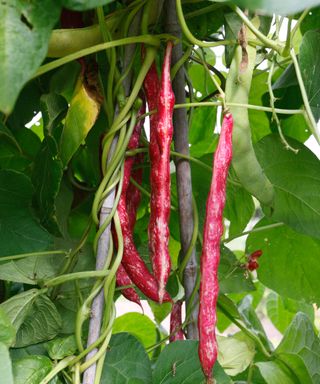
French Bean 'Borlotto Lingua Di Fuoco Nano'
Spectacular flat-podded bean, splashed with vivid red flecks. This distinctive climbing French variety is also called the ‘fire-tongue’ bean. Steaming helps retain its vibrant hues. A decorative and tasty classic that can be harvested from June to October.
4. Hunter

French Bean 'Hunter'
Super hard-working and high-yielding, yet also easygoing, this climbing green French bean is another AGM winner. It produces large crops of flat, stringless pods that can reach 8in (20cm) in length. White-seeded bean variety that is ideal for early and maincrop growing.
5. Amethyst

French Bean 'Amethyst'
This slender dwarf French bean has flavorsome, stringless pods up to 6in (15cm) long. Even the shelled beans are purple! Being compact, it makes an excellent candidate for pot cultivation on a sunny patio, and it also produces charming mauve blooms.
6. Monte Gusto
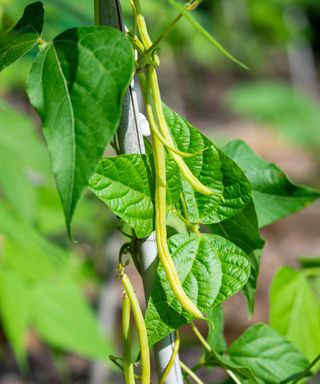
French Bean 'Monte Gusto'
High-yielding and early cropping, this bright climbing French bean produces tender, slender golden pods. Just as happy on the plot and in patio containers, and resistant to bean mosaic virus. This tubular pole variety can be harvested until October.
7. Blue Lake
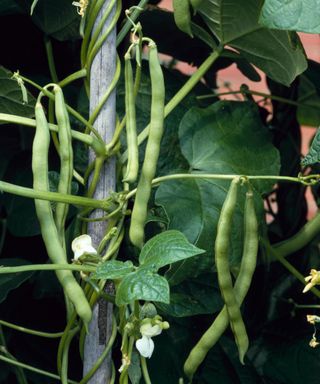
French Bean 'Blue Lake'
Another popular ‘pencil’ bean, this green climbing variety is prolific, tender and sweet. The last few crops can be dried to make fab haricots. This heirloom bean also produces a charming bright white flower and looks pretty trained up a wigwam. Harvest from July to October.
8. Purple Teepee

French Bean 'Purple Teepee'
Striking nearly-black purple dwarf variety. Produces copious beans in attractive pods up to 6in (15cm) long. Pods grow at the top of the plant, which means the beans are easier to pick. Its vivid purple-pink flowers look especially lovely in the kitchen garden.
Where to buy French Beans
You can buy French bean seeds from a wide range of suppliers. Use our quicklinks below to head straight to leading suppliers, and try some of our recommendations on how to grow French beans for yourself.
Where to buy French bean seeds in the UK:
- Shop French beans seeds at Amazon
- Shop French beans seeds at Crocus
- Shop French beans seeds at Dobies
- Shop French beans seeds at Kings Seeds
- Shop French beans seeds at Mr Fothergill's
- Shop French beans seeds at Suttons
- Shop French beans seeds at Thompson & Morgan
- Shop French bean seeds at Waitrose Garden
- Shop French bean seeds at You Garden
Where to buy French bean seeds in the US:
- Shop French bean seeds at Amazon
- Shop French bean seeds at Burpee
- Shop French bean seeds at Home Depot
- Shop French bean seeds at Walmart
Can I preserve French bean colors in cooking?
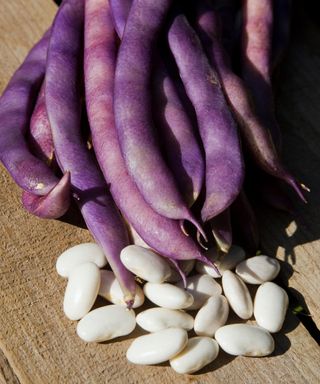
Some of the purples in varieties such as 'Blue Coco' will be lost in cooking, but there are ways to hang on to some of the hues
Some of the lovely strong tones on your beans will be lost in the process of cooking. Purple pods like ‘Cosse Violette’ and ‘Purple Queen’ are vivid at harvest, but it is normal for those deep hues to change in the pan.
The pigments - known as the anthocyanins - are water-soluble and sensitive to water pH, and high temperatures cause them to break down. That said, you can preserve some of those purplish tones if you steam or sear the beans or add them to sir-fries rather than boiling them.
Want to grow other plants to liven up stir-fries? Find out how to grow courgettes with our expert tips.
Soaking the beans in lemon juice or vinegar can also help retain some of the anthocyanins. The reason for this is that it raises the acidity levels (hence the pH). This trick is handy with citrus-based dishes or in Asian cuisine.
You can also preserve greens and yellows in the pan (and prevent the colors mixing with others). Just add ice cubes once the beans have heated up in the pan. It works, believe us!
So there, now you know everything there is to know about how to grow French beans. Good luck in your podding endeavours, and here’s to a happy harvest…

As assistant editor of Amateur Gardening magazine, Janey's gardening passion was fostered from an early age, when her amazing mum had her deadheading hydrangeas, mulching roses, and propagating strawberry plants from runners for school open days. She's also taken part in lots of conservation and rewilding projects for the RHS and TCV as a way of exploring her horticultural horizons.
-
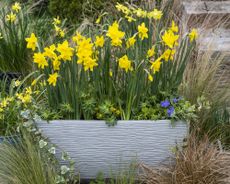 An Update on Gardeningetc
An Update on GardeningetcA word from our publisher
By Beth Murton Published
-
 Do you need to chit potatoes? Find out what the experts say
Do you need to chit potatoes? Find out what the experts sayGrow Your Own Learn how to chit potatoes before planting them in the ground and you’ll be on your way to getting an earlier and bigger harvest
By Drew Swainston Published
